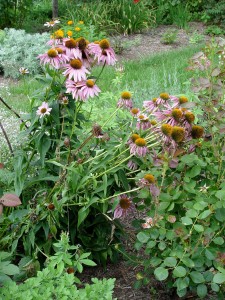Back in Business
July 24th, 2012
That soaking rain we got Friday and Saturday came at a good time. I got 1.6 inches — enough to do some actual good for plant roots and lawns.
The rain not only wetted parched roots and broke the high-90 heat wave, it was enough to switch most plants back into growth mode from survival mode.
And that’s opened the door to a lot of jobs you should’ve been putting off while our landscape was just trying to survive.
Tops on the list is mowing the lawn. I cut mine over the weekend for the first time in 6 weeks. The grass is greening nicely again and growing. Go ahead and cut yours if you haven’t already.
Another big job I’ve been tackling is cleaning up the perennials.
If you’ve dived headlong into perennials thinking they were low-care plants, you know now that most of them need assorted care to look good. One of the main mid-summer jobs is deadheading spent flowers and cutting back foliage that’s flopping, diseased or beat up from the heat and dry weather.
Daylilies have been getting most of my attention. The flower scapes really detract from the plant once the flowers are done. The bare stems stick up like sore thumbs and then turn brown. I pulled off brown ones and cut back the bare greens ones, one by one by one.
Most of my daylilies suffer from leaf streak disease this time of year. It starts with little rust-colored streaks that expand, coalesce and quickly turn whole blades brown.
About half of my plants needed de-leafed… all by hand-picking. Not much is left of some plants already. When this disease gets bad enough, I just cut the entire plants off to near ground level. The good news is that fresh foliage soon appears, and the plants go on to look fairly decent later in the season. They also come back fine the next year. But this does create extra work.
I also gave my catmint its annual mid-summer cutback to a few inches. Ditto for several yarrow plants, which are done flowering and were flopping. Like a lot of perennials, these will grow fresh foliage that’ll be more compact and better looking than if I just let the early-season growth alone.
I snipped the sun-burned foliage off the coralbells, deadheaded the shasta daisies and snipped the spent and bare tops off my lilies.
Weeds have been popping up even throughout the heat wave, so I’ve been continually pulling baby pokeweed, purslane, black medic and such every time I’m in a garden bed.

Floppy coneflowers can be staked or pruned, although they look better when supported heading into the season.
One job that it’s now too late to do is trim back the late-blooming perennials, such as mums, asters and sedum. Some of these already have begun to set flower buds. The time to size-control these plants is late spring through about the end of June. Then let them alone.
It’s not too late to try and stake up tall plants that are flopping but that either haven’t bloomed yet or that still have clean, green foliage. It’s a lot harder to stake plants back up after they’ve already flopped as opposed to giving them support to grow up from the beginning, but that’s really your only option now. Better to have them look straitjacketed than to be laying across the lawn.
Compost your cuttings, except for foliage that’s been hit by disease. Unless you’re turning your compost pile enough that it gets hot and steamy, it’s better to toss diseased foliage than to risk letting fungal spores survive that will go back on your beds when you use the compost.
Enjoy the growing plants. Green ones look a lot better than brown ones, don’t they?








